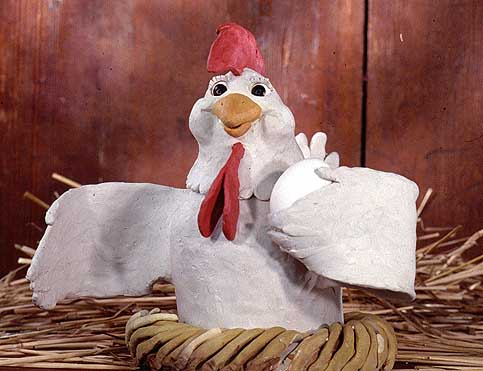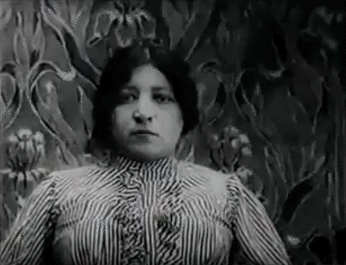|
Animation
Animation is a filmmaking technique whereby still images are manipulated to create moving images. In traditional animation, images are drawn or painted by hand on transparent celluloid sheets to be photographed and exhibited on film. Animation has been recognised as an artistic medium, specifically within the entertainment industry. Many animations are either traditional animations or computer animations made with computer-generated imagery (CGI). Stop motion animation, in particular claymation, has continued to exist alongside these other forms. Animation is contrasted with live action, although the two do not exist in isolation. Many moviemakers have produced films that are a hybrid of the two. As CGI increasingly approximates photographic imagery, filmmakers can easily composite 3D animations into their film rather than using practical effects for showy visual effects (VFX). General overview Computer animation can be very detailed 3D animation, while 2D c ... [...More Info...] [...Related Items...] OR: [Wikipedia] [Google] [Baidu] [Amazon] |
Computer Animation
Computer animation is the process used for digitally generating Film, moving images. The more general term computer-generated imagery (CGI) encompasses both still images and moving images, while computer animation refers to moving images. Virtual cinematography, Modern computer animation usually uses 3D computer graphics. Computer animation is a digital successor to stop motion and traditional animation. Instead of a physical model or illustration, a digital equivalent is manipulated frame-by-frame. Also, computer-generated animations allow a single graphic artist to produce such content without using actors, expensive set pieces, or Theatrical property, props. To create the illusion of movement, an image is displayed on the computer monitor and repeatedly replaced by a new similar image but advanced slightly in time (usually at a rate of 24, 25, or 30 frames/second). This technique is identical to how the illusion of movement is achieved with television and Film, motion pictur ... [...More Info...] [...Related Items...] OR: [Wikipedia] [Google] [Baidu] [Amazon] |
Animaniacs
''Animaniacs'' is an American Animated series, animated Comedy television, comedy Musical film, musical television series created by Tom Ruegger and produced by Warner Bros. Television Animation. It originally aired on Fox Broadcasting Company, Fox's Fox Kids block in 1993, before moving to The WB in 1995, as part of its Kids' WB afternoon programming block, until the series ended on November 14, 1998. ''Animaniacs'' is the second animated series by Warner Bros. Television Animation to be produced in association with Steven Spielberg's Amblin Entertainment after ''Tiny Toon Adventures''. It initially ran a total of 99 episodes, along with a feature-length film, ''Wakko's Wish''. Reruns later aired on Cartoon Network from 1997 to 2001, Nickelodeon from 2001 to 2005, Nicktoons (American TV channel), Nicktoons from 2002 to 2005, and Discovery Family (known as The Hub Network at the time) from 2012 to 2014. ''Animaniacs'' is a variety show, with short Sketch comedy, skits featuring ... [...More Info...] [...Related Items...] OR: [Wikipedia] [Google] [Baidu] [Amazon] |
Traditional Animation
Traditional animation (or classical animation, cel animation, or hand-drawn animation) is an animation technique in which each frame is drawing, drawn by hand. The technique was the dominant form of animation of the 20th century, until there was a shift to computer animation in the industry, such as Traditional animation#Modern process, digital ink and paint, a modern form of traditional animation methods, and 3D computer animation. Process Writing and storyboarding Animation production usually begins after a story is converted into an animation film script, from which a storyboard is derived. A storyboard has an appearance somewhat similar to comic book panels, and is a shot by shot breakdown of the staging, acting and any camera moves that will be present in the film. The images allow the animation team to plan the flow of the Plot (narrative), plot and the composition of the imagery. Storyboard artists will have regular meetings with the film director, director and may redra ... [...More Info...] [...Related Items...] OR: [Wikipedia] [Google] [Baidu] [Amazon] |
Stop Motion Animation
Stop-motion (also known as stop frame animation) is an animation, animated filmmaking and special effects technique in which objects are physically manipulated in small increments between individually photographed frames so that they will appear to exhibit independent motion or change when the series of frames is played back. Any kind of object can thus be animated, but puppets with movable joints (puppet animation) or clay figures (claymation) are most commonly used. Puppets, models or clay figures built around an Armature (sculpture), armature are used in model animation. Stop motion with live actors is often referred to as pixilation. Stop motion of flat materials such as paper, fabrics or photographs is usually called cutout animation. Terminology The term "stop-motion", relating to the animation technique, is often spelled without a hyphen as "stop motion"—either standalone or as a compound modifier. Both orthographic variants, with and without the hyphen, are correct, b ... [...More Info...] [...Related Items...] OR: [Wikipedia] [Google] [Baidu] [Amazon] |
Who Framed Roger Rabbit
''Who Framed Roger Rabbit'' is a 1988 American fantasy comedy film directed by Robert Zemeckis from a screenplay written by Jeffrey Price and Peter S. Seaman. It is loosely based on the 1981 novel ''Who Censored Roger Rabbit?'' by Gary K. Wolf. The film stars Bob Hoskins, Christopher Lloyd, Stubby Kaye, and Joanna Cassidy, along with the voices of Charles Fleischer and an uncredited Kathleen Turner. Combining Live-action animated film, live-action and animation, the film is set in an alternate history Hollywood, Los Angeles, Hollywood in 1947, where humans and cartoon characters (referred to as "toons") co-exist. Its plot follows Eddie Valiant, a private Detective, investigator with a grudge against toons, who must help exonerate Roger Rabbit, a toon Frameup, framed for murder. Walt Disney Pictures purchased the film rights for the story in 1981. Price and Seaman wrote two drafts of the script before Disney brought in executive producer Steven Spielberg and his production comp ... [...More Info...] [...Related Items...] OR: [Wikipedia] [Google] [Baidu] [Amazon] |
Stop Motion
Stop-motion (also known as stop frame animation) is an animated filmmaking and special effects technique in which objects are physically manipulated in small increments between individually photographed frames so that they will appear to exhibit independent motion or change when the series of frames is played back. Any kind of object can thus be animated, but puppets with movable joints (puppet animation) or clay figures (claymation) are most commonly used. Puppets, models or clay figures built around an armature are used in model animation. Stop motion with live actors is often referred to as pixilation. Stop motion of flat materials such as paper, fabrics or photographs is usually called cutout animation. Terminology The term "stop-motion", relating to the animation technique, is often spelled without a hyphen as "stop motion"—either standalone or as a compound modifier. Both orthographic variants, with and without the hyphen, are correct, but the hyphenated one is th ... [...More Info...] [...Related Items...] OR: [Wikipedia] [Google] [Baidu] [Amazon] |
Claymation
Claymation, sometimes called clay animation or plasticine animation, is one of many forms of stop-motion animation. Each animated piece, either character or background, is "deformable"—made of a malleable substance, usually plasticine clay. Traditional animation, from cel animation to stop motion, is produced by recording each frame, or still picture, on film or digital media and then playing the recorded frames back in rapid succession before the viewer. These and other moving images, from zoetrope to films and video games, create the illusion of motion by playing back at over ten to twelve frame rate, frames per second. Technique Each object or character is sculpted from clay or other such similarly pliable material as plasticine, usually around a wire skeleton, called an armature, and then arranged on the set, where it is photographed once before being slightly moved by hand to prepare it for the next shot, and so on until the animator has achieved the desired amount ... [...More Info...] [...Related Items...] OR: [Wikipedia] [Google] [Baidu] [Amazon] |
Rubber Hose Animation
Rubber hose animation was the first animation style that became standardized in the American animation field. The defining feature is a curving motion that most animated objects possess, resembling the motion and physical properties of a rubber hose. While the style fell out of fashion by the mid-1930s, it has seen a renewed interest since the 2010s. History Beginnings and rise In the early days of hand drawn animation in the 1920s, the studios' main areas were not in Hollywood, but New York City. Animation was a new phenomenon and there were no experienced animators; yet there were skilled artists working on newspapers, creating comic strips in a time when even the comic strips themselves were relatively new. Many of them became fascinated with the introduction of moving drawings, and saw them as new possibilities and challenges to use their skills on something they found more exciting than the newspaper strips. For this reason, many of the first cartoons had similarities wit ... [...More Info...] [...Related Items...] OR: [Wikipedia] [Google] [Baidu] [Amazon] |
Tiny Toon Adventures
''Tiny Toon Adventures'' is an American animated television series created by Tom Ruegger and produced by Warner Bros. Animation. It originally aired from September 14, 1990 to December 6, 1992, airing in syndication before eventually settling at Fox Broadcasting Company, Fox's Fox Kids block. It was the first animated series by Warner Bros. Animation to be produced in association with Steven Spielberg's Amblin Entertainment. The show follows the adventures of a group of young cartoon characters who attend Acme Looniversity to become the next generation of characters from the ''Looney Tunes'' series. The pilot episode, "The Looney Beginning", aired as a prime-time special on CBS on September 14, 1990, while the series itself was featured in first-run syndication for the first two seasons. The final season aired on Fox Broadcasting Company, Fox under the Fox Kids programming block. The series ended production in 1992 in favor of ''Animaniacs'', which premiered a year later; howeve ... [...More Info...] [...Related Items...] OR: [Wikipedia] [Google] [Baidu] [Amazon] |
Cutout Animation
Cutout animation is a form of stop-motion animation using flat characters, props and backgrounds cut from materials such as paper, card, stiff fabric or photographs. The props would be cut out and used as puppets for stop motion. The world's earliest known animated feature films were cutout animations (made in Argentina by Quirino Cristiani), as is the world's earliest surviving animated feature '' Die Abenteuer des Prinzen Achmed'' (1926) by Lotte Reiniger. The technique of most cutout animation is comparable to that of shadow play, but with stop motion replacing the manual or mechanical manipulation of flat puppets. Some films, including ''Die Abenteuer des Prinzen Achmed'', also have much of their silhouette style in common with shadow plays. Cutout animation pioneer Lotte Reiniger studied the traditions of shadow play and created several shadow play film sequences, including a tribute to François Dominique Séraphin in Jean Renoir's film '' La Marseillaise'' (1938). W ... [...More Info...] [...Related Items...] OR: [Wikipedia] [Google] [Baidu] [Amazon] |






